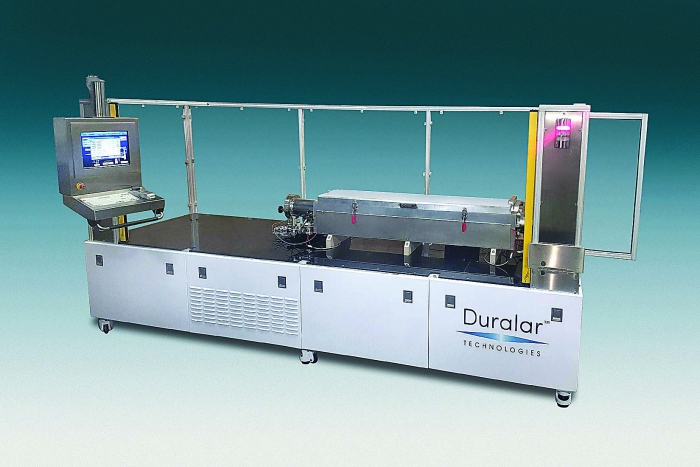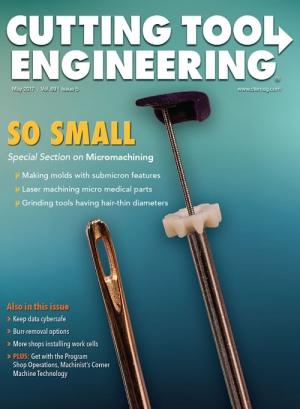Cutting tool and wear parts manufacturers use diamond-like carbon (DLC) coatings to increase wear resistance and reduce friction. Though coatings have improved over time, there are limitations on how thick a coating can be deposited and the time needed to apply the coatings.
Conventional DLC coatings, which have a practical total thickness limit of around 5µm, are deposited one or two atoms at a time. As a result, it can take more than 8 hours to deposit a 1µm-thick DLC coating.
To increase coating thickness and reduce deposition time, the new CS-50 deposition system from Duralar Technologies uses a process called DualArmor. This process can apply DLC coatings of 50µm or thicker—and apply them at rates averaging 15µm to 20µm per hour, with considerably higher rates possible. And where traditional systems spray coatings, limiting what can be coated to line of sight, the CS-50 can coat the inside and outside surfaces of metal parts.

The Duralar CS-50 deposition system can deposit thicker coatings than was previously possible or commercially feasible. Image courtesy of Duralar Technologies.
The CS-50 features a tubular processing chamber that opens like a clamshell, allowing metal parts to be placed inside for coating. According to the company, it employs a unique hollow-cathode, plasma-enhanced chemical vapor deposition (PECVD) process that bathes parts in an intense plasma—roughly 1,000 times more intense than a standard CVD plasma. This enables parts to be coated at “an unprecedented high rate,” according to Duralar’s chief technology officer, Tom Casserly. That plasma bath eliminates the line-of-sight limitations that spray-type coatings have. Because all deposition occurs within the dense plasma, “all part surfaces—interior, exterior and complex 3D shapes—are coated with high uniformity,” reducing or eliminating the need for post-processing rework.
Casserly explained that Duralar’s PECVD process creates a pendulum-like motion of high-energy electrons traveling back and forth between the sides of the chamber—the cathode, with the two ends of the chamber serving as the anodes. Inside the chamber, high-energy, ionized gases are used to clean, create an adhesive bond and deposit ultrahard coating on the parts.
According to Duralar, the new DualArmor coatings provide five to 10 times the hardness of carbon steel and more than 10,000 times greater wear resistance than 304 stainless steel. The coatings feature high levels of corrosion and erosion resistance, and they are virtually frictionless, having a coefficient of friction of less than 0.08. Their carbon content gives the coatings natural lubricity, which in certain applications eliminates the need for other lubricants. All the coatings are chemically inert, benign and eco-friendly.
For more information about Duralar Technologies, Tucson, Ariz., visit www.duralar.com or call (520) 812-6926.
Related Glossary Terms
- chemical vapor deposition ( CVD)
chemical vapor deposition ( CVD)
High-temperature (1,000° C or higher), atmosphere-controlled process in which a chemical reaction is induced for the purpose of depositing a coating 2µm to 12µm thick on a tool’s surface. See coated tools; PVD, physical vapor deposition.
- chemical vapor deposition ( CVD)2
chemical vapor deposition ( CVD)
High-temperature (1,000° C or higher), atmosphere-controlled process in which a chemical reaction is induced for the purpose of depositing a coating 2µm to 12µm thick on a tool’s surface. See coated tools; PVD, physical vapor deposition.
- hardness
hardness
Hardness is a measure of the resistance of a material to surface indentation or abrasion. There is no absolute scale for hardness. In order to express hardness quantitatively, each type of test has its own scale, which defines hardness. Indentation hardness obtained through static methods is measured by Brinell, Rockwell, Vickers and Knoop tests. Hardness without indentation is measured by a dynamic method, known as the Scleroscope test.
- lubricity
lubricity
Measure of the relative efficiency with which a cutting fluid or lubricant reduces friction between surfaces.
- wear resistance
wear resistance
Ability of the tool to withstand stresses that cause it to wear during cutting; an attribute linked to alloy composition, base material, thermal conditions, type of tooling and operation and other variables.


